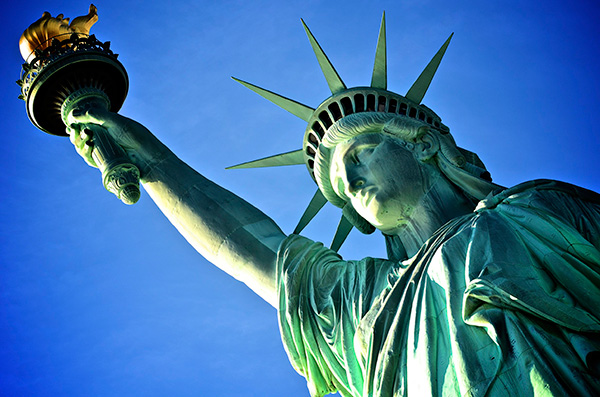The history of the Statue of Liberty, Liberty Island, New York, United States
The Statue of Liberty, New York, United States
This enormous neo-classical statue is now a world-famous icon. It represents the very essence of the French People and the ideals at the center of American Constitution, Freedom & Liberty for all. The figure itself is based on Libertas, the Roman Goddess of Freedom.

The Statue of Liberty.
Conceived 1865 Glatigny, Near Versailles, France, completed in the USA October 28, 1886 at Ellis Island.
Structural Engineers Eugene Viollet-le-Duc (died 1879) and Gustave Eiffel 1832-1923
Plinth Designed by the Architect Richard Morris Hunt 1827-1895
Fredric Auguste Bartholdi and Gustave Eiffel
The Architect/Sculptor Fredric Auguste Bartholdi conceived the idea of the statue in 1865 after a dinner at the home of Edouard-Rene Lefebvre de Laboulaye. The colossal statue was to be a gift from The French People to the people of the USA to celebrate the 100th anniversary of their independence from Great Britain. Or it could have been to celebrate the end of the American civil war or the end of slavery, no one is quite sure. It is certain however that the tablet held in her hand shows the date July 4th 1776, better known as Independence Day.
There was a problem though; no one had ever built anything on this scale since the bronze Colossus at Rhodes circa 280 BC. Bartholdi first appointed Eugene Viollet-le-Duc but, after a few years work, sadly Monsieur Viollet-le-Duc passed away.
Bartholdi then contacted an up-and-coming French structural engineer, a certain Gustave Eiffel. This was years before Eiffel’s second and perhaps even more iconic structure, The Eiffel Tower. Eiffel was chosen because of his understanding of wind forces.
The design of the 204-ton statue is shown in these contemporary photographs taken by Albert Fernique, which are in the New York Public Library, These photographs were taken in one of the many factories involved in producing the work of art and show the construction methods.

Photographs of the construction of The Statue of Liberty taken by Albert Fernique
Eiffel’s revolutionary structural design, which at the time would be the tallest cast iron structure ever built, was also one of the first examples of curtain walling ever produced. He used cast iron to construct an iron truss tower, from which he hung a secondary non-load bearing framework. This was a stroke of genius as the design allowed for the statue to be able to expand during the heat of summer and to contract during freezing winters.
This secondary skeleton was then clad in iron saddles, or iron bands, these bands were then insulated with asbestos, to prevent galvanic corrosion between the dissimilar metals and the hung with more than 300 individually hand beaten copper tiles.
The statue was completely assembled in Paris, dismantled and shipped to the USA.
The pedestal and Joseph Pulitzer
Originally the French were going to give the massive pedestal as part of the gift. However it was deemed too costly. The French raised the funds by lottery and public subscriptions.
The project was not instantly taken to heart by the American Government or indeed the American public. Funding was refused by congress for the plinth. Even at a state level funds were not forth coming.
Joseph Pulitzer to the rescue. He formed a fund-raising committee and made a promise to publish in print the name of every single citizen that contributed towards the project, in his newspapers no matter how small their contribution was. This caught the public’s imagination and the donations came flooding in. 120,000 donations were received by the committee of which more than 80% were in donations less than $1.00. The plinth was very much funded by the poor. I think the ideals the statue stood for must have resonated with the underclass.
The concrete plinth itself, which was designed by the noted American Architect Richard Morris Hunt, The Plinth was at the time the largest concrete structure ever poured. Hunt donated his fee to the project.
The statue’s copper plates would have been a shiny surface until the protective green patina formed. If our beautiful copper-colored PVD had been available, it would still appear as was intended, a beautiful, bright, welcoming copper giant that would sparkle in the sun and moonlight.

Liberty Enlightening The World in its natural copper color











